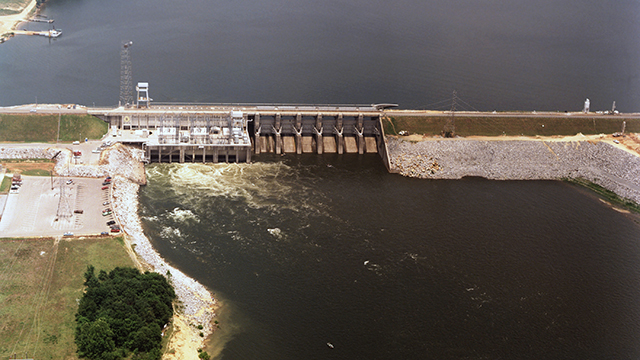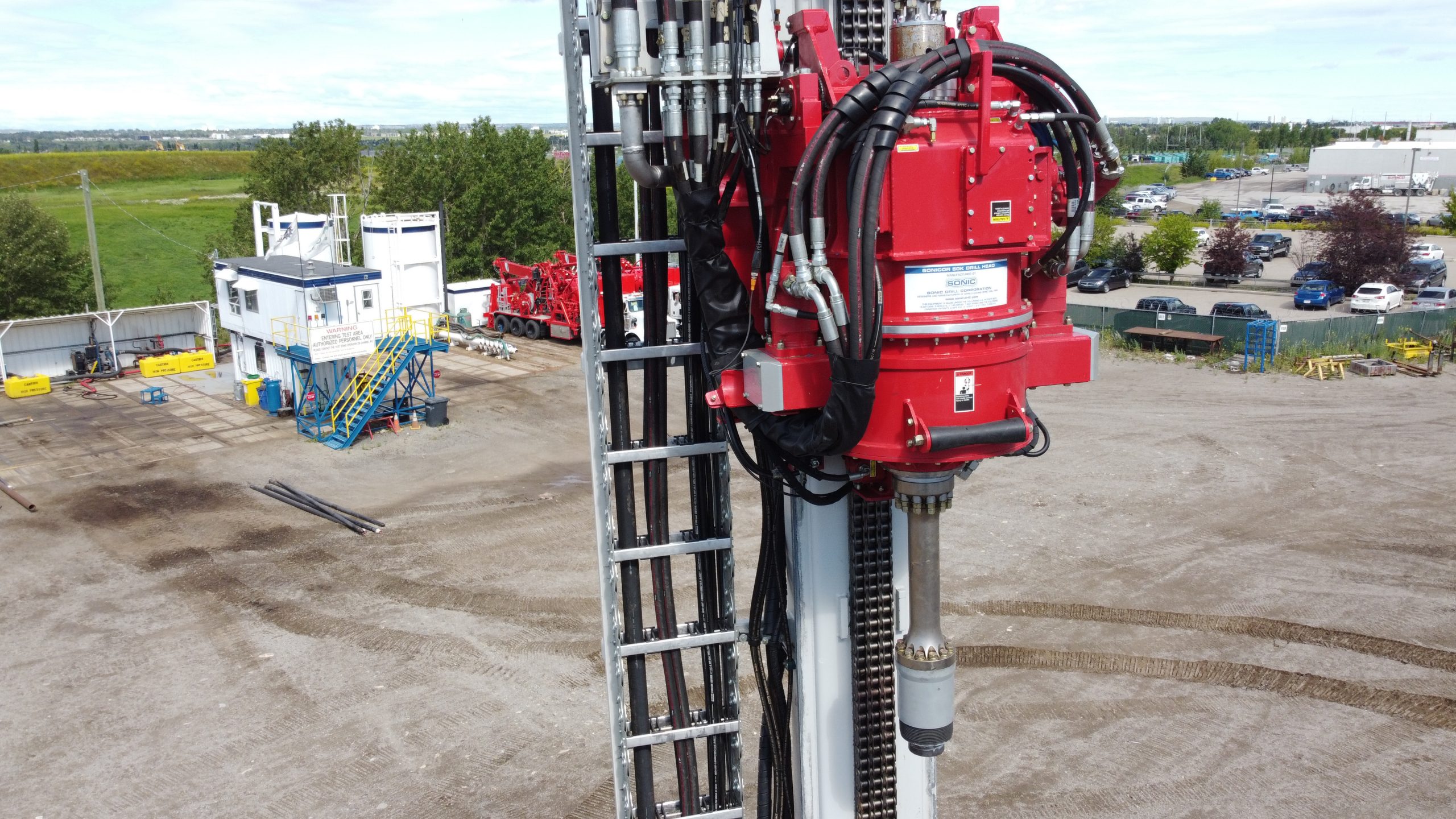With approximately 5,000 embankment dams over 40 years of age, utilities and local governments in the eastern United States have their work cut out for them.
There are many methods of stabilizing dams that are leaking. One of these involved the consolidation of the bedrock upon which the dam is situated as well as the earth, boulders, gravel and rock of which the dam is constructed. This involves drilling and filling many holes and voids to which drilled holes give access. Voids are filled with grout to consolidate and stabilize the dam’s geological makeup. Methods of drilling these holes varies from situation to situation, but one approach is to use a two-step method that involves sonic drilling technology to drive casing through the overburden down to the bedrock and then applying high pressure water-drilling technology to drill to depth through the bedrock.
Looking for cost & time efficiencies
With a full slate of dam stabilization work at hand, Alabama Power thought they could realize efficiencies by combining water and sonic drilling technologies. In September 2018, through their contracting division, Southern Company, they put out a tender for the design and construction of a hybrid water/sonic drill rig.
“With today’s technology, we knew that a combined drill rig was possible,” recalls Eric Manning, Geostructural Services Supervisor with Alabama’s Southern Company’s Hydro Services/Dam Safety division. “The numbers we put together showed that it would save on capital, time, add precision and improve worker safety.”
MEDATech Engineering came back with the winning proposal, and 18 months later the water/sonic drill rig is complete. Dubbed the WS6000, the track-mounted drill rig capable of drilling 6-inch nominal diameter holes, is the first hybrid drill rig that incorporates both high pressure water down-the-hole (DTH) and sonic drilling technologies.
“It’s an exciting breakthrough,” says MEDATech Engineering President Robert Rennie. “The rig is equipped with one top-drive unit capable of both sonic and high pressure water drilling. Switching between the two is a seamless process.”
The rig is capable of delivering very granular geotechnical data in real time anywhere on the globe. An additional feature is a fully autonomous rod-handling system that can move both casing and rods separately or as one in and out of the mast.
“This provides a much greater degree of safety,” notes Manning, “than we see anywhere in the industry today.”

WS6000 is purpose-built for embankment dams
The Logan Martin embankment dam in Vincent, AL was built as a part of an Alabama Power Company construction program situated on the Coosa River in the late 1950s. Built for power generation, the dam gave rise to Logan Martin Lake, a recreational gem known to locals as “the lake with a thousand coves.”
With 200 vertical feet of waterhead, hydrostatic pressure has been eroding the dam’s karst limestone foundations for many decades, and stabilization efforts have been ongoing since 1968.
“It’s this specific type of embankment dam that the WS6000 was designed to remediate,” explains Manning. “Drilling is an essential part of stabilization, equally if not more essential to the safety of the dam as the grouting part of the work.” Manning notes a progressive shift in philosophy as to what constitutes safe drilling methods. “Our regulators have influenced safety tremendously, and water hammer in combination with sonic drilling is the safest method of drilling on embankments.”
Stabilizing embankment dams involves drilling through overburden—often over 100 feet of it—and sinking the casing into bedrock. The casing is grouted it in, excess grout is drilled out, and the bedrock is drilled to depth in order to access fissures and voids. The geotechnical voids are filled with grout all the way down the hole.
While a water hammer drill will go through the earth, sand and loose rock of the overburden with ease, doing so would destabilize the substrate. That’s why a sonic head is used to drill through overburden—it minimizes disturbance. The water hammer is used for bedrock, and for drilling out excess material once the hole’s footing is grouted in. It is powered by water pressurized to 3000 psi, which delivers energy and environmental benefits over other methods. Water at the drill head is also used to flush cuttings up the inside of the casing, where they are settled out and the water is returned to the river.

Wassara hydraulic water DTH hammer drill
The hybrid rig is a new prototype based on known, proven technology. MEDATech started with their tried-and-tested Borterra W6000 drill rig, which incorporates a Wassara hydraulic water DTH hammer drill built by Sweden’s LKAB Wassara AB. The Wassara drill has a solid reputation for drilling long, straight holes with a high degree of precision.
“Its flexibility and accuracy is unmatched in the industry,” says Steve Archer, head of MEDATech’s Borterra Drilling sales. “It sets the industry standard for water hammer drills. And it’s quickly becoming a game changer for customers looking for a faster, more environmentally friendly solution.”
With no drilling fluid or oil injection and no airborne dust, the water hammer doesn’t contaminate the surrounding environment. It’s the solution often chosen when water contamination is a risk, for example in creating grout curtains along rivers and streams. It’s the Wassara water hammer drill that was chosen for drilling holes in the seabed as part of the Costa Concordia cruise ship salvation project. It goes without saying that for water retention dam geotechnical drilling, environmental impact is equally important.

Sonic Drill Corporation rotary vibratory drill
The sonic drill head is also cutting-edge technology, from a leader in the sector, Sonic Drill Corporation based in British Columbia, Canada. Sonic’s rotary vibratory drills are capable of high drilling speeds because the drill bit vibrates up and down at a high frequency while being pushed down and rotated. These three forces combine to allow the drill to move rapidly through most compositions of overburden. The vibratory action of the drill causes the surrounding soil to fluidize, thereby allowing effortless penetration. Water is used to remove cuttings and speed up operation.
The WS6000 drill is mounted on crawlers and uses a 415-horsepower Cummins diesel engine to drive the hydraulics. MEDATech outfitted the rig with sophisticated automated rod handling, remote operating system maintenance and real-time data modelling.
Straight-and-true efficiency
The embankment dam stabilization process almost always involves two drill rigs, which represent a large capital outlay and a large maintenance expense. A complicating factor is the structure of the karst underneath the Logan Martin dam embankment, which makes switching between sonic and water hammer a necessity.
“Karst contains lots of angle fractures and voids,” explains Manning. “The water hammer drill bit will follow the path of least resistance, so you can end up with unacceptable deviation from the intended path. Normally we would have to switch rigs to correct that, which is not a fast process. With a combined drill rig, we can quickly switch between drilling heads to keep the borehole straight. That alone will save a tremendous amount of time.”
The hybrid drill rig comes with a capital cost of approximately USD $2 million, while maintenance on one rig rather than two drives down costs even more. The added mechanized rod handling reduces labour requirements.
Real-time geotechnical data
The WS6000 has a native ability to map geotechnical formations, which is a big plus for Southern Company. “With karst especially, we need to know what we’re drilling into,” explains Manning. “Having that geotechnical information in real time will help on many levels.”
The onboard data mapping shows what the drill is moving through, whether it’s sand, limestone or granite, as well as the approximate shape and volume of any voids. “You can graph anything you like,” explains Rennie. “To access that data in real time, all you need is a WiFi or GSM connection.”
Remote connectivity is also at play for drill rig maintenance. MEDATech can log in to access rig system parameters remotely and make adjustments as needed. “We call it the Tesla of drill rigs,” laughs Rennie. “We can optimize robotics and other rig functions from 1,000 miles away.”

Rod-handling automation increases safety, drives productivity
Most drill rigs require two to three crew members to operate the rig and insert drill casings and rod. The WS6000 requires a single operator, since the rod-handling system can handle drill rods, casings, or drill rod within casing. “It’s the only system I’m aware of that can do that,” says Rennie.
Safety was top of mind in creating the rod handling system, since technicians’ handling of heavy casings and rods by hand has been known to cause severe injuries. “Most rigs need a lot of handling, but this one keeps personnel out of harm’s way,” says Manning. “The rod bot feature demonstrates the level of safety put into this drill rig. Eliminating that danger was critical.”
The rod-handling system is fully robotic. The operator can pick up rod and casings from the ground, define the path the rod takes to the mast and set the angle of approach for any given hole. Then, once the operator gets each successive piece of rod or casing into the clamp, the rod-handling system takes over. Every piece follows a defined path to the mast and is inserted automatically at the correct angle.
“Aside from reducing man hours, it’s also faster,” notes Rennie. “With hand-bombing you’re limited to what workers can lift.” With a traditional rig, workers typically manhandle 5-foot sections of casing into the mast, which adds up to 24 sections of casing for a 120-foot hole. The WS6000’s automated system reduces that to 6 sections of 20-foot casing. “Each dam stabilization project involves drilling and filling hundreds of holes,” says Rennie. “We’re hoping to gain productivity on each hole while keeping workers out of harm’s way.”
Remote-controlled drilling on the horizon
When the embankment dam at Vale’s Córrego do Feijão iron ore mine near Brumadinho, Brazil failed—with catastrophic consequences—in January 2019, the company quickly put embankment dam stabilization on the fast track. Now they are looking to up the ante on worker safety. “Our friends at Sonic Drill Corp connected us with Vale Brazil’s geotechnical team lead in June 2020,” says Rennie. “It seems they are looking for a remote-controlled drilling system that can be operated from half a mile away. I don’t see why we couldn’t do that.”
Not everyone requires hybrid drilling technology or a drill rig that can be controlled remotely, but a rig with this level of rod-handling automation is attractive to just about everyone. Rennie sums it up well. “From a health and safety point of view, rod handling is one of the biggest hazard areas in the drilling industry. So if you can eliminate that risk—and also save time and man hours—why wouldn’t you?”